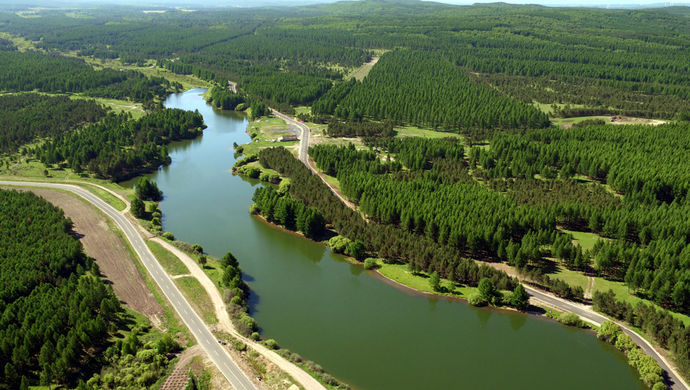Mechanism enables countries to combat desertification

The forest coverage of Saihanba has increased from 16,000 hectares to 74,700 hectares, making it the largest man-made forest in the world.
A cooperation mechanism was initiated on Sept. 10 in Erdos, Inner Mongolia Autonomous Region during the 13th Session of the Conference of the Parties to the UN Convention to Combat Desertification (UNCCD). It aims to promote green development, technologies and investment in the countries along the proposed routes of the “Belt and Road” (B&R) initiative. In addition to railroads, the participating cities are thus connected in an invisible way.
The countries will stand together to deal with challenges and difficulties, and share experience in combating desertification, hence building a community of shared ecological security.
The earth is under the constant threat of desertification. Of the 65 countries involved in the B&R initiative, more than 60 are affected by desertification, land deterioration and draught. When hearing the word “desert,” many think of a barren land where nothing grows. However, deserts should be considered a resource because they can produce a variety of opportunities in the long run.
“Deserts will become home to green food and green treasure. Desertification will be stemmed if we follow natural and economic principles,” said Wang Tao, director of the Northwest Research Institute for Resources of the Ecological Environment at the Chinese Academy of Sciences (CAS).
During the conference, the UN Environment Programme released a report on the ecological wealth created in China’s Kubuqi Desert that assessed the ecological value of the desert and China’s management from the perspective of desert economics. In total, China has transformed 6,460 square kilometers of desert into productive land in Kubuqi, generating a value of 500 billion yuan and helping one million local people to escape poverty, according to the report.
Siim Kiisler, the Estonian Minister for the Environment, praised China’s achievements in desertification control in Kubuqi. China’s work there over the past three decades has offered lessons for the countries participating in the “B&R” initiative and others around the world, he said.
“What makes China successful is the adoption of a market mechanism that secures legal rights of regulators and incentivizes enterprises and the public to join it as well. We adapted our measures to local conditions and properly developed desert economy, lending experience for global management of land sustainability and the fight against desertification,” said Zhang Yongli, deputy director of China’s State Forestry Administration.
Feldspathic sandstone, which has been called the “cancer of the environment,” is pervasive throughout the Erdos Plateau. Experts there said that most plants are not able to survive on the land except for sea-buckthorn. The root system of sea-buckthorn grows vertically, which enables the plant to embed itself in cracks inside feldspathic sandstone, thus checking the wind and fixing the shifting sand. Policies and technologies that facilitate ecological and industrial interventions against desertification have diversified the plant resources of the desert.
Practitioners in the desert land have offered evidence to identify academic opinion. China’s achievements have been made possible by government leadership, public involvement, technological innovation and legal support. Technological research forms the foundation. “We integrate relevant technological outcome and apply them to areas of concentrated desert. The establishment of a series of pilot projects and demonstration zones has given birth to a typical model of green development in the desert,” said Zhang Hongwen, chief economist of the State Forestry Administration.
At the same time, the experience of dealing with desertification has been shared in a variety of regions. “China’s technologies for preventing and controlling road desertification have been applied to the Sahara Desert, providing solutions for road construction in coastal and desert areas,” said Lei Jiaqiang, a research fellow from the Institute of Xinjiang Ecology and Geography at CAS. Under the cooperation mechanism, China will contribute to global collaboration in desertification control by aligning demonstrations zones with the countries along the proposed routes of the “B&R” initiative and building exchange platforms for regular negotiation.
The cooperation mechanism aims to achieve zero growth of land degradation and further connect the peoples along the participating countries of the “B&R” initiative, said Monique Barbut, the Executive Secretary of the UNCCD.
These countries are bonded with mountains and waters. They form a community of common ecological destiny. All countries need to face the challenges together to access shared ecological security. The “B&R” initiative has become a green path for technological exchanges and human interaction, said Pan Yingzhen, director of the Department of Desertification Prevention and Control under the State Forestry Administration.
Deserts vary in terms of society, economy and natural environment. In order for deserts to be changed into oases, nations must change their development mindset while adopting new production models and daily lifestyle. Management of desertification is aligned with the struggle to end poverty. In addition to innovation concepts and technology, mechanism design plays a bigger role in connecting humans involved in these two fields.
Presently, China has an area of 2.6 million square kilometers of desert land, taking account of 27.2 percent of the total territory. Around 35 percent of the distressed counties and nearly 30 percent of the impoverished population live within in desert areas. Given the circumstances, desert regions pose a challenge for ecological management and they are the focus of poverty eradication.
China has found solutions to stem the damage of desertification and the key to unlocking the potential of deserts through persistent innovation of mechanisms.
Patricia Appiagyei, deputy minister of Environment, Science, Technology and Innovation of Ghana, said that China impressed her with its integrated management of desertification and poverty. Deserts are considered an opportunity rather than an obstacle. The process of greening the deserts has created jobs and fostered businesses. This is an inspiration for the countries along the proposed routes of the “B&R” initiative.

 PRINT
PRINT CLOSE
CLOSE